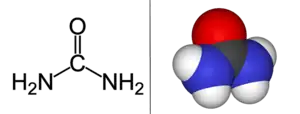Urea-containing cream
 2D and 3D image of urea molecule | |
| Names | |
|---|---|
| Trade names | Decubal, Carmol 40, Keralac, others |
| Clinical data | |
| Pregnancy category |
|
| Routes of use | Topical |
| Defined daily dose | Not established[1] |
| External links | |
| AHFS/Drugs.com | Multum Consumer Information |
| US NLM | Urea-containing cream |
| Legal | |
| Legal status |
|
Urea, also known as carbamide-containing cream, is used as a medication and applied to the skin to treat dryness and itching such as may occur in psoriasis, dermatitis, or ichthyosis.[2][3][4] It may also be used to soften nails.[4]
In adults side effects are generally few.[5] It may occasionally cause skin irritation.[2] Urea works in part by loosening dried skin.[6] Preparations generally contain 5 to 50% urea.[3][4]
Urea containing creams have been used since the 1940s.[7] It is on the World Health Organization's List of Essential Medicines.[8] It is available over the counter.[4] In the United Kingdom 100 g of 10% cream costs the NHS about 4.37 pounds.[3]
Medical uses
Urea cream is indicated for debridement and promotion of normal healing of skin areas with hyperkeratosis, particularly where healing is inhibited by local skin infection, skin necrosis, fibrinous or itching debris or eschar.[6] Specific condition with hyperkeratosis where urea cream is useful include:
- Dry skin and rough skin[6]
- Dermatitis[6]
- Psoriasis[6]
- Ichthyosis[6]
- Eczema[6]
- Keratosis[6]
- Keratoderma[6]
- Corns[6]
- Calluses[6]
- Damaged, ingrown and devitalized nails[6]
Dosage
The defined daily dose is not established.[1]
Side effects
Common side effects of urea cream are:
In severe cases, there can be an allergic reaction with symptoms such as skin rash, urticaria, difficulty breathing and swelling of the mouth, face, lips, or tongue.[9]
Mechanism of action
Urea in low doses is a humectant while at high doses (above 20%) it causes breakdown of protein in the skin.[10]
Urea dissolves the intercellular matrix of the cells of the stratum corneum, promoting desquamation of scaly skin, eventually resulting in softening of hyperkeratotic areas.[6] In nails, urea causes softening and eventually debridement of the nail plate.[6]
References
- 1 2 "WHOCC - ATC/DDD Index". www.whocc.no. Archived from the original on 1 July 2021. Retrieved 13 September 2020.
- 1 2 World Health Organization (2009). Stuart MC, Kouimtzi M, Hill SR (eds.). WHO Model Formulary 2008. World Health Organization. p. 310. hdl:10665/44053. ISBN 9789241547659.
- 1 2 3 British national formulary : BNF 69 (69 ed.). British Medical Association. 2015. pp. 796–798. ISBN 9780857111562.
- 1 2 3 4 "Urea topical medical facts from Drugs.com". www.drugs.com. Archived from the original on 18 January 2017. Retrieved 15 January 2017.
- ↑ Katsambas, Andreas; Lotti, Torello; Dessinioti, Clio; D'Erme, Angelo Massimiliano (2015). European Handbook of Dermatological Treatments (3 ed.). Springer. p. 439. ISBN 9783662451397. Archived from the original on 2017-01-16.
- 1 2 3 4 5 6 7 8 9 10 11 12 13 14 "Urea Cream - FDA prescribing information, side effects and uses". www.drugs.com. Archived from the original on 18 January 2017. Retrieved 15 January 2017.
- ↑ Loden, Marie; Maibach, Howard I. (1999). Dry Skin and Moisturizers: Chemistry and Function. CRC Press. p. 235. ISBN 9780849375200. Archived from the original on 2017-01-16.
- ↑ World Health Organization (2019). World Health Organization model list of essential medicines: 21st list 2019. Geneva: World Health Organization. hdl:10665/325771. WHO/MVP/EMP/IAU/2019.06. License: CC BY-NC-SA 3.0 IGO.
- 1 2 3 4 5 drugs.com > Urea Cream (Consumer Information) Archived 2011-02-26 at the Wayback Machine Issue Date: May 4, 2011
- ↑ Sethi, A; Kaur, T; Malhotra, SK; Gambhir, ML (2016). "Moisturizers: The Slippery Road". Indian Journal of Dermatology. 61 (3): 279–87. doi:10.4103/0019-5154.182427. PMC 4885180. PMID 27293248.
External links
| Identifiers: |
|---|